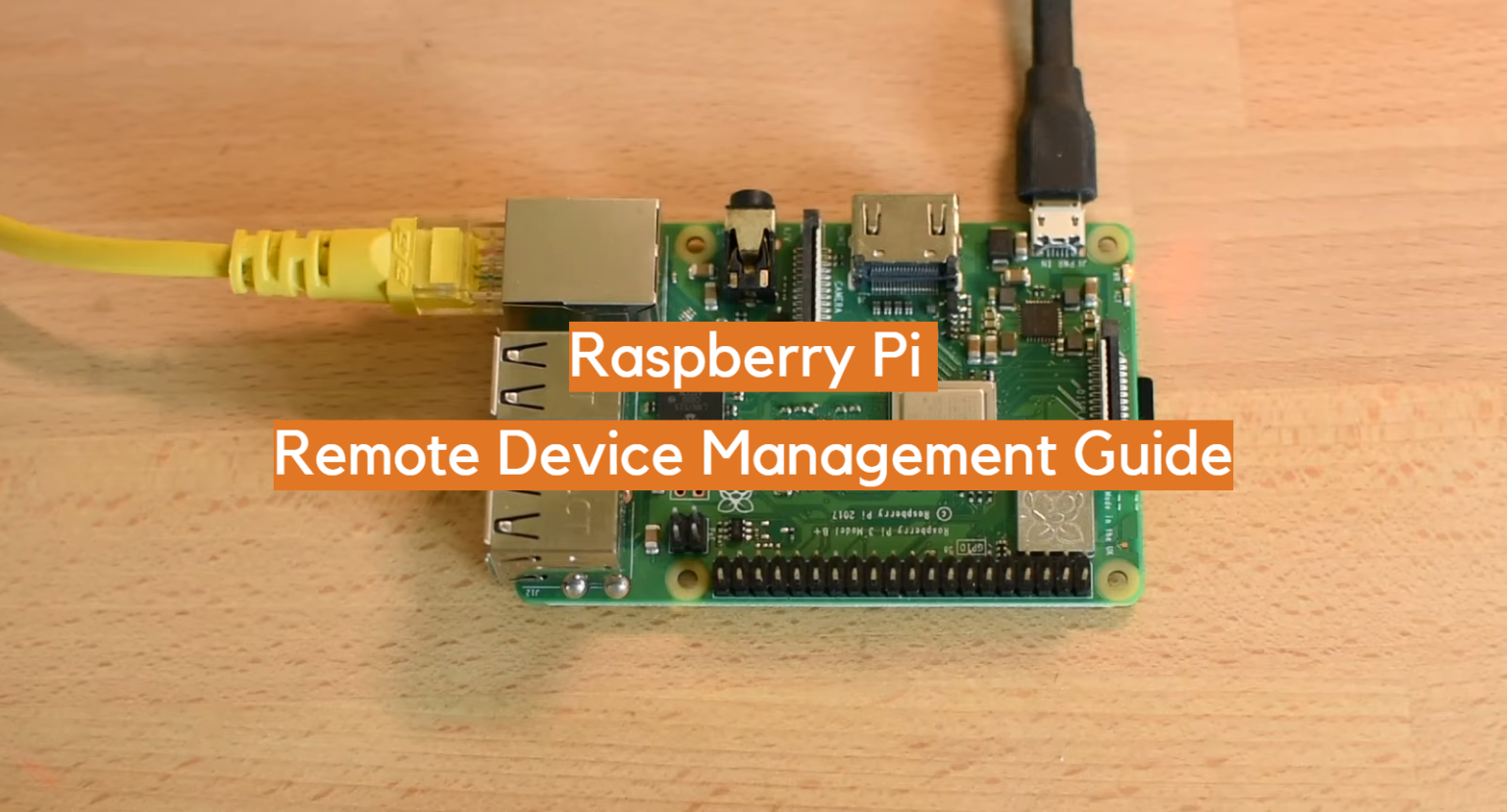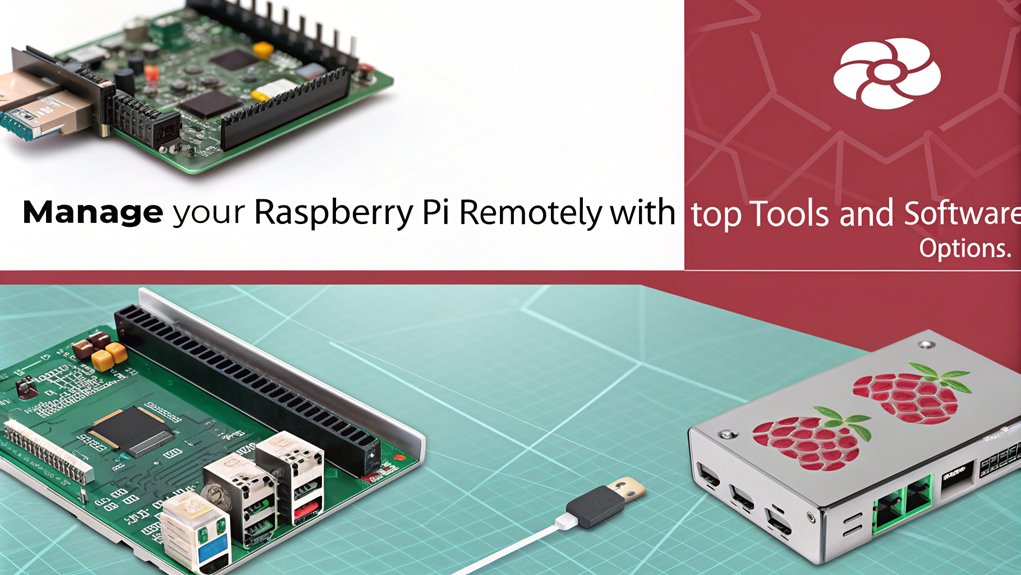Easy Raspberry Pi Remote Management: Your Complete Guide!
Ever found yourself needing to tweak a setting on your Raspberry Pi, only to realize its tucked away in a location thats anything but convenient? The ability to manage your Raspberry Pi remotely is not just a convenience; it's a necessity for unlocking the full potential of these versatile microcomputers, especially in today's rapidly evolving IoT landscape.
Remote management of Raspberry Pi essentially boils down to controlling the device from a different location. This is achieved through specialized software and tools, allowing you to interact with your Pi as if you were sitting right in front of it. This approach has gained significant traction, primarily due to its inherent flexibility and efficiency, making it an ideal solution for Internet of Things (IoT) applications, where devices are often deployed in remote or inaccessible locations. Imagine managing a network of sensors in a sprawling agricultural field, or monitoring environmental conditions in a remote research station all from the comfort of your office. The possibilities are virtually limitless.
| Category | Information |
|---|---|
| Device | Raspberry Pi (various models) |
| Operating System | Raspberry Pi OS (formerly Raspbian), Linux-based |
| Remote Management Methods | SSH, VNC, RDP, RemoteIoT Management Platforms |
| Key Benefits | Cost Reduction, Improved Scalability, Streamlined Maintenance, Reduced Downtime |
| Use Cases | IoT Applications, Home Automation, Remote Monitoring, Edge Computing |
| Security Considerations | Secure Connections (SSH Keys), Firewalls, VPNs |
| Future Trends | AI Integration, Machine Learning Applications, Cloud-Based Management |
| Reference Website | Raspberry Pi Foundation |
However, the road to seamless remote management isn't always smooth. Managing multiple Raspberry Pi devices, especially when they are scattered across different geographical locations, can present a unique set of challenges. Imagine trying to update software on hundreds of devices, each requiring individual attention. This is where a robust remote management platform becomes indispensable.
- Movierulz Im Visier Aktuelle Filmnews Streaming Alternativen
- Filmyfly Co 2025 Filme Serien Alternativen Was Sie Wissen Mssen
The management of Raspberry Pi remotely, especially when coupled with a dedicated remote IoT management platform, emerges as a powerful solution for anyone seeking to elevate their IoT projects. By leveraging such a platform, users gain the ability to manage their devices efficiently, securely, and effectively, regardless of their physical location. This centralized control streamlines operations and reduces the complexities associated with managing distributed devices.
Today, we will delve into three distinct methods for accessing your Raspberry Pi remotely, ensuring both effectiveness and security. We will explore the nuances of each approach, providing you with the knowledge to choose the method that best suits your specific needs and technical expertise. These methods will empower you to take full control of your Raspberry Pi, no matter where you are in the world.
It is important to remember that we will be working with Raspberry Pi microcomputers, which are fundamentally different from microcontrollers like the Raspberry Pi Pico. Microcomputers boast a full-fledged operating system and processing capabilities, allowing for more complex tasks and applications. Furthermore, it's crucial to acknowledge that not every method outlined will be compatible with every Raspberry Pi board. The suitability of a particular method depends on the specific hardware and software configuration of your device.
- Plexprobleme Gelst So Benennen Sortierst Du Deine Filme Richtig
- Bollywood News Aktuell Filmstarts Trailer Streamingtipps
A well-designed remote management platform offers a suite of robust features, advanced security measures, and seamless scalability. These characteristics make it an indispensable tool for effectively managing IoT devices, ensuring their optimal performance and security. Such platforms typically provide features such as remote access, software updates, configuration management, and performance monitoring, all accessible through a user-friendly interface.
At its core, IoT device management involves organizing, configuring, and maintaining IoT devices. This encompasses a wide range of tasks, including device provisioning, software updates, security patching, and performance monitoring. The ultimate goal is to provide the ability to remotely manage these processes, paving the way for sophisticated and efficient IoT remote management systems.
The importance of IoT remote management cannot be overstated. It ensures that all IoT devices are functioning seamlessly, without any disruptions or performance degradation. Moreover, it provides the capability to detect and address any problems that may arise, minimizing downtime and maximizing the overall effectiveness of the IoT system.
So, what are the tangible benefits of using a remote IoT platform specifically tailored for Raspberry Pi remote management? Let's explore the advantages in detail.
Utilizing a remote IoT management platform for managing Raspberry Pi devices remotely unlocks a multitude of benefits, significantly enhancing both productivity and efficiency. These benefits extend across various aspects of IoT project management, from reducing operational costs to improving scalability and security.
One of the most immediate and impactful advantages is the substantial reduction in operational costs. By enabling remote management, you can minimize the need for on-site visits and manual interventions, saving time and resources. This is particularly crucial for large-scale IoT deployments, where the cost of physically accessing each device can be prohibitive.
With the right setup and tools, you can effortlessly manage files, execute commands, and even access the full desktop environment of your Raspberry Pi all from the convenience of your laptop or smartphone. This level of control empowers you to troubleshoot issues, deploy updates, and monitor performance without the need for physical access to the device.
Preparing your Raspberry Pi for headless operation, meaning operating without a monitor, keyboard, or mouse, begins with enabling SSH (Secure Shell). SSH is an essential protocol for secure remote management, providing an encrypted connection between your device and the Raspberry Pi. This ensures that all communication is protected from eavesdropping and tampering.
The initial step in this process involves using an imaging tool to write the Raspberry Pi OS image to your SD card. This essentially installs the operating system onto the card, making it bootable on the Raspberry Pi. Once the OS is installed, you can proceed with the headless setup.
Next, you'll need to mount the '/boot' partition of the SD card on your computer. This partition contains configuration files that need to be modified to enable SSH and configure other remote management settings. By mounting this partition, you can directly access and edit these files.
Hopefully, by this point in the tutorial, you will have successfully installed the Cockpit management tool on your Raspberry Pi. Cockpit is a web-based interface that provides a user-friendly way to manage your Raspberry Pi remotely. It offers a range of features, including system monitoring, software updates, and user management.
This tool is an incredibly powerful and useful asset for remotely managing your devices. Its intuitive interface and comprehensive features make it a valuable addition to any Raspberry Pi deployment, simplifying complex tasks and enhancing overall manageability.
This article will explore the best practices, essential tools, and effective techniques for managing your Raspberry Pi remotely, leveraging the power of the remote IoT management platform, one of the most innovative solutions available today. We will delve into the specifics of configuring and utilizing this platform to optimize your remote management capabilities.
The advantages of remote management of Raspberry Pi are numerous, encompassing streamlined maintenance procedures, reduced downtime in critical applications, and improved scalability to accommodate growing IoT deployments. These benefits collectively contribute to a more efficient, reliable, and cost-effective IoT ecosystem.
The Raspberry Pi remote device management guide serves as a comprehensive overview of the various tools available for remotely accessing and managing a Raspberry Pi device. It provides insights into the capabilities and limitations of each tool, enabling you to make informed decisions about which tools are best suited for your specific needs.
The bedrock of remote Raspberry Pi management is the establishment of a secure and reliable connection between the user's device (such as a laptop or smartphone) and the Raspberry Pi. This connection is the gateway to remote access and control, and its security is paramount to protect your device and data.
The future of Raspberry Pi management is brimming with possibilities, fueled by advancements in artificial intelligence (AI), machine learning (ML), and cloud computing. These technologies are paving the way for even more innovative and sophisticated solutions for remote management, pushing the boundaries of what's possible.
Here are some key trends to watch out for in the evolving landscape of Raspberry Pi management:
One prominent trend is the integration of AI and ML into remote management platforms. These technologies can automate tasks, predict potential issues, and optimize device performance, further enhancing the efficiency and effectiveness of remote management.
Another significant trend is the growing adoption of cloud-based management solutions. Cloud platforms offer scalability, reliability, and accessibility, making them ideal for managing large-scale Raspberry Pi deployments. They also provide centralized control and monitoring capabilities, simplifying the management process.
Enhanced security measures will continue to be a top priority. As IoT devices become increasingly interconnected, the need for robust security protocols and threat detection mechanisms becomes even more critical. Future solutions will likely incorporate advanced encryption, authentication, and intrusion detection techniques.
Edge computing, which involves processing data closer to the source, is also gaining traction in the context of Raspberry Pi management. By performing data processing on the edge, you can reduce latency, improve bandwidth utilization, and enhance the privacy of sensitive data.
Learn how to securely connect to your Raspberry Pi or IoT device remotely over the internet, without the complexities and security risks associated with port forwarding. This streamlined approach simplifies remote access and enhances the overall security of your IoT deployment.
Explore various methods such as SSH, VNC, and RDP, and discover how to leverage pinggy.io to create secure tunnels for seamless remote management. These techniques provide secure and reliable access to your Raspberry Pi, regardless of your network configuration.
Ultimately, the goal is to enhance your IoT device control and management capabilities, empowering you to monitor, manage, and maintain your devices from anywhere in the world, with confidence and security. This level of control is essential for unlocking the full potential of your IoT projects and driving innovation across various industries.
- Movierulz 2025 Telugu Tamil Mehr Filme Online Finden Streamen
- Movierulz Im Visier Aktuelle Filmnews Streaming Alternativen

Raspberry Pi Remote Device Management Guide ElectronicsHacks

Top Raspberry Pi Remote Management Software Control Your Device Anywhere Ly Using Phone Raspler

Raspberry Pi Remote Management What You Need to Know